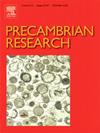Concentration of cobalt in IOCG systems: Exemplified by the Proterozoic Kangdian IOCG metallogenic province, SW China
IF 3.2
2区 地球科学
Q2 GEOSCIENCES, MULTIDISCIPLINARY
引用次数: 0
Abstract
Cobalt was defined as an important strategic metal by major industrial countries. The clan of iron oxide copper–gold (IOCG) deposits has been documented to be a potentially important Co provider (predicted to be accounting for > 10 % of continental Co resources), but the mechanism for Co concentration in IOCG systems is still poorly constrained. In this study, we conducted a combined geological, mineralogical and geochemical investigation on the Co enrichments/mineralization in the Lala, Dahongshan and Yinachang deposits from the Proterozoic Kangdian IOCG metallogenic province, SW China (with an estimated total Co resource of > 70,000 t). These deposits have a similar paragenesis consisting of early Fe-oxides and late Cu-sulfides mineralization stages. This study revealed that Co in these deposits is mainly hosted in pyrite, with the way by substituting for Fe2+. The Co-rich pyrite grains in the Lala deposit have formed in two generations. The early generation (Py I; 5432 to 27,883 ppm Co), clearly predating the Fe-Cu mineralization, is characterized by massive pyrite bands concordant with the hosting strata, and thus were suggested to be syn-sedimentary in origin. These grains were commonly overprinted by late Fe-Cu mineralization through a fluid-aided dissolution-reprecipitation process during which the primary Co in Py I were leached. The second generation of Co-rich pyrite (Py II; 2152 to 8329 ppm Co) was closely associated with Cu-sulfides of the Cu mineralization. On the other hand, only one generation of Co-rich pyrite was present in the Dahongshan and Yinachang deposits, and are synchronous with the Cu mineralization.
Chemical and S isotopic compositions show that all the Co-rich pyrite grains from the Lala (both Py I and Py II), Yinachang and Dahongshan deposits have a notable S isotopic peak value around at ∼ 3 ‰ with similar high Co/Ni (mostly > 1), but low Mo/Ni (mostly < 0.001) ratios, indicating strong affinities of mafic provenances for the Co metals. The Co in the sedimentary Py I grains of Lala was constrained to be likely related to the coeval mafic volcanic activities (as potential Co sources). On the other hand, the Co of the Cu stage in the Lala (i.e. Py II), Dahongshan, and Yinachang deposits were suggested to be sourced from coeval mafic magmas or hosting mafic rocks through fluid-rock interaction. However, the former source could be insignificant, as the potential Co contents of the mafic magma-derived fluids were estimated to be lower than 12.0 ppm. In contrast, our mass balance calculation strongly confirmed that large amounts of Co in the mafic hosting rocks were mobilized or leached during fluid-rock interaction. Considering that such kind of Fe or Cu mineralizing fluids are comparable in various IOCG deposits (e.g., high salinity, NaCl-rich), we further proposed that the Co budgets of hosting rocks would be the first key factor controlling variable Co enrichments/mineralization in IOCG systems. This study highlights that Co-rich hosting/country rocks (e.g., ultramafic–mafic rocks or Co-rich black shales) presenting in specific IOCG deposits could be potentially important indicators for Co enrichments/mineralization in the IOCG systems.
钴在IOCG系统中的富集——以康店元古代IOCG成矿区为例
钴被主要工业国家确定为重要的战略金属。氧化铁铜金(IOCG)矿床家族已被证明是一个潜在的重要Co供应商(预计将占>;占大陆Co资源的10%),但IOCG系统中Co富集的机制仍然知之甚少。本文对中国西南康店IOCG成矿省元古界拉拉、大红山和银厂3个矿床的Co富集/成矿进行了地质、矿物学和地球化学综合调查(估计Co总资源量为6800万美元)。这些矿床具有相似的共生作用,包括早期的铁氧化物和晚期的铜硫化物矿化阶段。研究表明,这些矿床中的Co主要以取代Fe2+的方式赋存于黄铁矿中。拉拉矿床富钴黄铁矿颗粒形成于两代。早期代(Py I;5432 ~ 27,883 ppm Co),明显早于Fe-Cu成矿作用,具有与寄主地层一致的块状黄铁矿带特征,可能为同沉积成因。这些颗粒通常是通过流体辅助溶解-再沉淀过程中晚期Fe-Cu矿化的叠加,在此过程中,Py I中的初级Co被浸出。第二代富钴黄铁矿(Py II;2152 ~ 8329 ppm Co)与Cu矿化中的Cu-硫化物密切相关。另一方面,大红山和银厂矿床只存在一代富钴黄铁矿,且与铜成矿同步。化学和S同位素组成表明,拉拉(pyi和pyii)、银厂和大红山矿床的富Co黄铁矿颗粒均在~ 3‰附近有一个显著的S同位素峰值,Co/Ni较高(大部分为>;1),但低Mo/Ni(主要是<;0.001)的比值,表明钴金属具有很强的磁性来源亲和力。拉拉沉积的Py - I颗粒中的Co可能与同期海相火山活动有关(作为潜在的Co来源)。另一方面,拉拉(即Py II)、大红山和银厂矿床中Cu阶段的Co可能来源于同世基性岩浆或寄存基性岩石,可能是流体-岩石相互作用的结果。然而,前一个来源可能是微不足道的,因为基性岩浆衍生流体的潜在Co含量估计低于12.0 ppm。相比之下,我们的质量平衡计算有力地证实,在流体-岩石相互作用过程中,基性岩中的大量Co被动员或浸出。考虑到这种类型的Fe或Cu成矿流体在不同的IOCG矿床(如高盐度、富nacl)中具有可比性,我们进一步提出,寄存岩石的Co收支将是控制IOCG系统中可变Co富集/成矿的第一个关键因素。本研究强调,在特定的IOCG矿床中出现的富钴承载岩(如超基性基性岩或富钴黑色页岩)可能是IOCG系统中Co富集/矿化的潜在重要指标。
本文章由计算机程序翻译,如有差异,请以英文原文为准。
求助全文
约1分钟内获得全文
求助全文
来源期刊

Precambrian Research
地学-地球科学综合
CiteScore
7.20
自引率
28.90%
发文量
325
审稿时长
12 months
期刊介绍:
Precambrian Research publishes studies on all aspects of the early stages of the composition, structure and evolution of the Earth and its planetary neighbours. With a focus on process-oriented and comparative studies, it covers, but is not restricted to, subjects such as:
(1) Chemical, biological, biochemical and cosmochemical evolution; the origin of life; the evolution of the oceans and atmosphere; the early fossil record; palaeobiology;
(2) Geochronology and isotope and elemental geochemistry;
(3) Precambrian mineral deposits;
(4) Geophysical aspects of the early Earth and Precambrian terrains;
(5) Nature, formation and evolution of the Precambrian lithosphere and mantle including magmatic, depositional, metamorphic and tectonic processes.
In addition, the editors particularly welcome integrated process-oriented studies that involve a combination of the above fields and comparative studies that demonstrate the effect of Precambrian evolution on Phanerozoic earth system processes.
Regional and localised studies of Precambrian phenomena are considered appropriate only when the detail and quality allow illustration of a wider process, or when significant gaps in basic knowledge of a particular area can be filled.
 求助内容:
求助内容: 应助结果提醒方式:
应助结果提醒方式:


